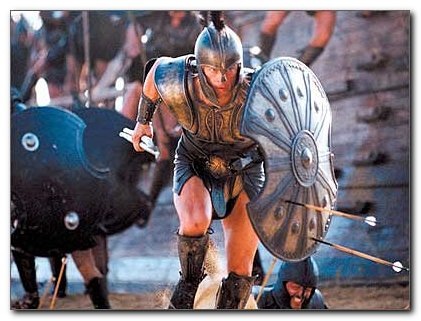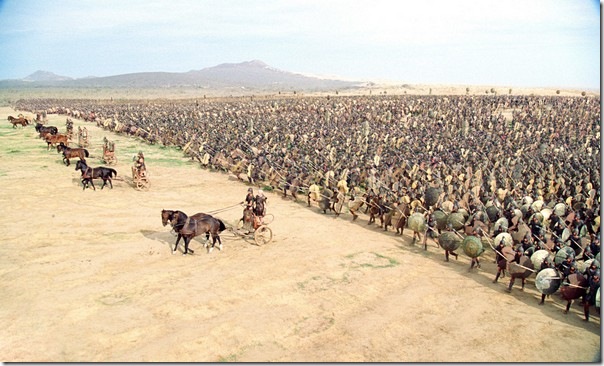OK, what about the movie now? I’ll start by commenting on the good parts.
 Firstly, Petersen’s film cleverly centers his narrative not on the main story – the stealing of Helen and the war – but on the two opposing heroes: Achilles played by Brad Pitt and Hector by Eric Bana.
Firstly, Petersen’s film cleverly centers his narrative not on the main story – the stealing of Helen and the war – but on the two opposing heroes: Achilles played by Brad Pitt and Hector by Eric Bana.
I found the choice of his two leads interesting: Brad Pitt very famously did an amazing physical prep for his role as the God of All Warriors, and more importantly for the couple of scenes when he gets to display half (and occasionally more) of his naked torso to all the salivating fan-girls. His Achilles looks a bit like a surfer dude in leather, shield, sword and sandals.
Eric Bana on the other hand looks more the stoic, serious, family man Hector who loves his newborn son and his wife Andromache, played by British actress Saffron Burrows but who doesn’t get to do much in the film beside look very stricken every time her screen husband is fighting the Greeks. Hector here is torn between his love for his brother Paris but also desires to smack him on his head for his adulterous affair with another man’s wife.
Both get scenes where they inspire their men, and interestingly in very different ways too. Achilles growls and fires up his elite Myrmidons – the ancient day equivalent of Navy SEALS LOL – by roaring “You are Lions!!!” before they storm the beaches of Troy. Hector on the other hand passionately tells his men to honor their wives and fight for their country in Braveheart fashion. He exudes little optimism that the Trojans can actually win the war, compared to his generals who pompously tell King Priam that Troy’s walls have never been breached.
So, you’ll be fascinated by Pitt’s Bad Boy Achilles. But it’s Bana’s Hector caught in a dilemma you’ll feel for.
A lot of how good any film retelling of the Trojan War also depends on the huge battle and individual duel scenes between the heroes.
And the Director’s Cut really doesn’t disappoint in this aspect. It doesn’t reach the height – and occasional absurdity – of The Return of the King, but it’s still incredibly filmed and doesn’t look fake. In fact, I think ROTK’s Battle of Pelennor Fields looked more obviously CGed than Troy does, even though just one year separates the two films’ productions.
And here’s one thing I really like about Troy as compared to John Woo’s Red Cliff. In that Chinese production, all the background fighting looks fake. You basically get all these inexperienced extras clacking their wooden swords at each other hoping every film goer’s attention is instead focused on how Zhou Yu is lopping heads off in the foreground.
In Petersen’s Troy on the other hand, battle scenes aren’t just violent – they actually look realistically violent. You won’t see extras clacking their wooden swords in the background hoping no one will notice. You’ll see swords meeting flesh, spears meeting eyeballs and throats, shields getting smashed, bodies being run over by racing chariots in the huge battle scenes.
I don’t know how Petersen’s crew trained all those extras to fight like their lives depended on it, but it really shows. And of all the modern day sword and sandal war movies I’ve seen, this is the only movie that doesn’t look CGed even if it really was, and the only one that gets one aspect of those murderous ancient battles right: that the fighting was so furious that dead and dismembered bodies just fell on top of each other. You’ll see that in Troy: Director’s Cut.
As kinetic as the large battle scenes are, it’s the individual duel scenes that everyone was talking about. The to-the-death fight scene between Hector and Achilles remains the singularly most exhilarating fight scene I’ve seen anywhere – and I’ve seen and can remember a lot. The more so that no stunt doubles were used. It’s amazingly choreographed, and filled with nuances you’ll be viewing several times over just to catch them all.
I’m reminded of the duels in Richard Lester’s two Three/Four Musketeer movies in the mid-70s which was stylistically almost exactly opposite. The scenes in those two movies didn’t look choreographed but in fact looked exactly as how sword fighting scenes are like – plenty of shoving, pushing, tripping, feinting etc.
The outcome of the contest between Hector and Achilles won’t be in doubt even for someone who has never heard of the legend and doesn’t know who will eventually be left standing. But it is a heartbreaking scene nonetheless when one of the two finally falls.

The last aspect of the film that I think needs mentioning for a job well-done is the interpretation of Agamemnon and Menelaus. The Agamemnon here is traditional: that he didn’t rally the Greek troops to simply bring Helen back: he wanted Troy’s subjugation for political reasons. Brian Cox is a little old to play the character, but if you can look past his age, he did a great job portraying the politically astute if proud and arrogant Greek Leader. You may not like him, but you have to respect his motivations for waging war.
Petersen’s Menelaus on the other hand deviates a little from the old sources here. In the legend, Menelaus was a relatively small background player of the story. But he genuinely loved his wife and wanted her back even after her adulterous elopement with Paris. So, a bit of a lovesick bird, so to speak.
The Menelaus in Troy however didn’t just want Helen back: he wanted her back so he could personally strangle her in anger. The Menelaus here is a womanizer who snorted that wives are only for breeding. The two onscreen brothers play off each other well, even though in the film they act like brutes.
Concluded in the next post.:)
Recent comments